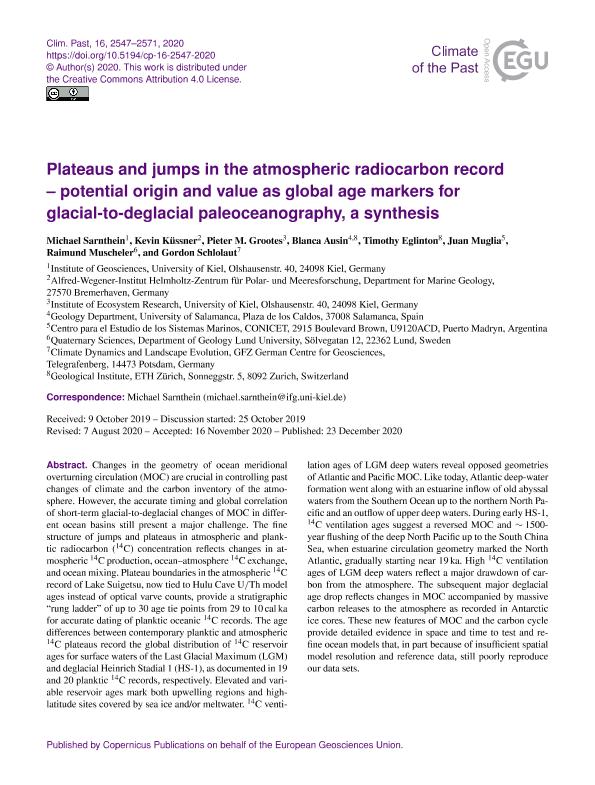Mostrar el registro sencillo del ítem
dc.contributor.author
Sarnthein, Michael
dc.contributor.author
Küssner, Kevin
dc.contributor.author
Grootes, Pieter M.
dc.contributor.author
Ausin, Blanca
dc.contributor.author
Eglinton, Timothy
dc.contributor.author
Muglia, Juan

dc.contributor.author
Muscheler, Raimund
dc.contributor.author
Schlolaut, Gordon
dc.date.available
2021-08-10T19:48:25Z
dc.date.issued
2020-12
dc.identifier.citation
Sarnthein, Michael; Küssner, Kevin; Grootes, Pieter M.; Ausin, Blanca; Eglinton, Timothy; et al.; Plateaus and jumps in the atmospheric radiocarbon record: Potential origin and value as global age markers for glacial-to-deglacial paleoceanography, a synthesis; Copernicus Publications; Climate of the Past; 16; 6; 12-2020; 2547-2571
dc.identifier.issn
1814-9332
dc.identifier.uri
http://hdl.handle.net/11336/138127
dc.description.abstract
Changes in the geometry of ocean meridional overturning circulation (MOC) are crucial in controlling past changes of climate and the carbon inventory of the atmosphere. However, the accurate timing and global correlation of short-term glacial-to-deglacial changes of MOC in different ocean basins still present a major challenge. The fine structure of jumps and plateaus in atmospheric and planktic radiocarbon (14C) concentration reflects changes in atmospheric 14C production, ocean-atmosphere 14C exchange, and ocean mixing. Plateau boundaries in the atmospheric 14C record of Lake Suigetsu, now tied to Hulu Cave U/Th model ages instead of optical varve counts, provide a stratigraphic "rung ladder" of up to 30 age tie points from 29 to 10 cal ka for accurate dating of planktic oceanic 14C records. The age differences between contemporary planktic and atmospheric 14C plateaus record the global distribution of 14C reservoir ages for surface waters of the Last Glacial Maximum (LGM) and deglacial Heinrich Stadial 1 (HS-1), as documented in 19 and 20 planktic 14C records, respectively. Elevated and variable reservoir ages mark both upwelling regions and high-latitude sites covered by sea ice and/or meltwater. 14C ventilation ages of LGM deep waters reveal opposed geometries of Atlantic and Pacific MOC. Like today, Atlantic deep-water formation went along with an estuarine inflow of old abyssal waters from the Southern Ocean up to the northern North Pacific and an outflow of upper deep waters. During early HS-1, 14C ventilation ages suggest a reversed MOC and ĝ1/41500-year flushing of the deep North Pacific up to the South China Sea, when estuarine circulation geometry marked the North Atlantic, gradually starting near 19 ka. High 14C ventilation ages of LGM deep waters reflect a major drawdown of carbon from the atmosphere. The subsequent major deglacial age drop reflects changes in MOC accompanied by massive carbon releases to the atmosphere as recorded in Antarctic ice cores. These new features of MOC and the carbon cycle provide detailed evidence in space and time to test and refine ocean models that, in part because of insufficient spatial model resolution and reference data, still poorly reproduce our data sets.
dc.format
application/pdf
dc.language.iso
eng
dc.publisher
Copernicus Publications

dc.rights
info:eu-repo/semantics/openAccess
dc.rights.uri
https://creativecommons.org/licenses/by/2.5/ar/
dc.subject
ATMOSPHERIC RADIOCARBON
dc.subject
PALEOCEANOGRAPHY
dc.subject.classification
Geoquímica y Geofísica

dc.subject.classification
Ciencias de la Tierra y relacionadas con el Medio Ambiente

dc.subject.classification
CIENCIAS NATURALES Y EXACTAS

dc.title
Plateaus and jumps in the atmospheric radiocarbon record: Potential origin and value as global age markers for glacial-to-deglacial paleoceanography, a synthesis
dc.type
info:eu-repo/semantics/article
dc.type
info:ar-repo/semantics/artículo
dc.type
info:eu-repo/semantics/publishedVersion
dc.date.updated
2021-03-12T19:14:50Z
dc.journal.volume
16
dc.journal.number
6
dc.journal.pagination
2547-2571
dc.journal.pais
Alemania

dc.journal.ciudad
Gotinga
dc.description.fil
Fil: Sarnthein, Michael. Christian Albrechts Universitat Zu Kiel; Alemania
dc.description.fil
Fil: Küssner, Kevin. Alfred-Wegener-Institut. Helmholtz-Zentrum für Polar und Meeresforschung; Alemania
dc.description.fil
Fil: Grootes, Pieter M.. Christian Albrechts Universitat Zu Kiel; Alemania
dc.description.fil
Fil: Ausin, Blanca. Universidad de Salamanca; España. ETH Zürich. Geological Institute; Suiza. Escuela Politécnica Nacional; Ecuador
dc.description.fil
Fil: Eglinton, Timothy. ETH Zürich. Geological Institute; Suiza
dc.description.fil
Fil: Muglia, Juan. Consejo Nacional de Investigaciones Científicas y Técnicas. Centro Científico Tecnológico Conicet - Centro Nacional Patagónico. Centro para el Estudio de Sistemas Marinos; Argentina
dc.description.fil
Fil: Muscheler, Raimund. Lund University; Suecia
dc.description.fil
Fil: Schlolaut, Gordon. German Research Centre for Geosciences; Alemania
dc.journal.title
Climate of the Past

dc.relation.alternativeid
info:eu-repo/semantics/altIdentifier/doi/http://dx.doi.org/10.5194/cp-16-2547-2020
dc.relation.alternativeid
info:eu-repo/semantics/altIdentifier/url/https://cp.copernicus.org/articles/16/2547/2020/
Archivos asociados
